The Impact of Morphological Features on Summer Temperature Variations on the Example of Two Residential Neighborhoods in Ljubljana, Slovenia
Abstract
:1. Introduction
2. Materials and Methods
2.1. Study Area
2.2. Methods and Tools
- urban structure: urban density, dimensions of buildings and in-between spaces, street widths and spacing, building typology, programme (housing, mixed use), and the weighted density;
- urban cover: fractions of built-up/paved/vegetated surfaces, vegetation type (tall vegetation impacts shadowing), bare soil and water;
- urban fabric: type of materials, colors, materialized surface properties in terms of heat conduction, heat storage, and other;
- urban metabolism: heat, water, and pollutants due to human activity on the micro scale (recording elements as: density of inhabitants in open space, air conditioning, rubbish bins, cars, open fires, and other).
- Compilation of historical maps, competition data, urban composition and processes of development (inventory of urban history and morphological evolution). Mapping of demographic data (population, density); urban history (origin, developing phases, and key alterations); geomorphological (topography, reliefs, terrain type, and climate conditions), and urban morphological data (border conditions). Analysis of urban morphology using GIS mapping. Data by the Surveying and Mapping Authority of the Republic of Slovenia. Software used: Esri ArcGis Software.
- Thermal satellite imagery was done based on Landsat data obtained from [27]. Landsat 8 satellite (launched as the Landsat Data Continuity Mission—LDCM on 11 February 2013) mission continues the acquisition of high-quality data that meet both NASA and USGS scientific and operational requirements for observing land use and land change [27]. We used Landsat 8 images for the production of the thermal map. This satellite records the Earth’s surface in 11 spectral bands suitable for observing the various activities on the Earth’s surface. Here we used Band 10. The thermal infrared bend or TIR shows surface heat. The images were processed using Esri ArcGis Software, which were transformed in a way to calculate temperature for each pixel separately.
- In situ measurement of air temperature; analysis of data on temperature at both locations, July 2016 (Figure 8). Observations were carried out during July 2016. Air temperatures were measured at many locations, 1.2 m above the ground in both neighborhoods from 7 to 15 July 2016, every day at 7 p.m. The locations were selected based on the data revealing higher temperatures than in the surroundings. During the recording period, the summer temperatures were first increasing, then decreasing, while the temperature differences between the warmest and the coldest days were more than 10 K. These data were compared against the temperatures recorded at the Koseze automated weather station, which is situated 5 m and 290 m away from the TRN and MRN neighborhoods, respectively (i.e., considering the minimum distance to the first building). In all cases, the measured temperature in the neighborhood was higher than that recorded at the weather station outside the densely built-up area.
- Analysis of insolation on 21 March 2016, 21 June 2016 (Figure 9), 23 September 2016, and 21 December 2016. The data were acquired via the Lidar viewer by the Slovenian Environmental Agency [16], processed using Esri ArcGis Software, and transformed into the digital terrain model. A solar insolation map was produced according to the movement of the sun.
- Fieldwork and photographic recording: site visits and street views dated from May to October 2016.
3. Results
3.1. Urban Morphology—Density, Orientation and Openness
3.2. Urban Cover—Connections between Cover, Function, and Material
3.3. Urban Fabric—Surfaces and Materials
3.4. Urban Metabolism—The Impact of Human Activities
4. Discussion
4.1. Green Areas
4.2. Orientation of Buildings’ Axes in Approx. N–S Direction
4.3. Urban Morphology
4.4. Pedestrian Areas
4.5. Immediate Vicinity of a Native Forest at the Edge of the Neighborhood
4.6. Water Areas—A Pond
5. Conclusions
Acknowledgments
Author Contributions
Conflicts of Interest
References
- Kosanović, S.; Hildebrand, L.; Stević, G.; Fikfak, A. Resilience of inland urban areas to disasters occurred due to extreme precipitations. Open Urban Stud. Demogr. J. 2015, 1, 41–51. [Google Scholar] [CrossRef]
- Plut, D. Vrednotenje geografskega okolja in okoljska etika. Dela 2008, 29, 63–75. [Google Scholar] [CrossRef]
- Arnds, D.; Böhner, J.; Bechtel, B. Spatio-temporal variance and meteorological drivers of the urban heat island in a European city. Theor. Appl. Climatol. 2015. [Google Scholar] [CrossRef]
- Cocci Grifoni, R.; D’Onofrio, R.; Sargolini, M.; Pierantozzi, M.A. Parametric Optimization Approach to Mitigating the Urban Heat Island Effect: A Case Study in Ancona, Italy. Sustainability 2016, 8, 896. [Google Scholar] [CrossRef]
- Emmanuel, R.; Loconsole, A. Green infrastructure as an adaptation approach to tackling urban overheating in the Glasgow Clyde Valley Region, UK. Landsc. Urban Plan. 2015, 138, 71–86. [Google Scholar] [CrossRef]
- O’Malley, C.; Piroozfarb, P.A.E.; Farr, E.R.P.; Gates, J. An investigation into minimizing urban heat island (UHI) effects: A UK perspective. Energy Procedia 2014, 62, 72–80. [Google Scholar] [CrossRef]
- Erell, E.; Pearlmutter, D.; Boneh, D.; Bar Kutiel, P. Effect of high-albedo materials on pedestrian heat stress in urban street canyons. Urban Clim. 2014, 10, 367–386. [Google Scholar] [CrossRef]
- Salata, F.; Golasi, I.; de Lieto Vollaro, A.; de Lieto Vollaro, R. How high albedo and traditional buildings’ materials and vegetationaffect the quality of urban microclimate. A case study. Energy Build. 2015, 99, 32–49. [Google Scholar] [CrossRef]
- Prado, R.T.A.; Ferreira, F.L. Measurement of albedo and analysis of its influence the surface temperature of building roof materials. Energy Build. 2005, 37, 295–300. [Google Scholar] [CrossRef]
- Huang, C.; Ye, X. Spatial Modeling of Urban Vegetation and Land Surface Temperature: A Case Study of Beijing. Sustainability 2015, 7, 9478–9504. [Google Scholar] [CrossRef]
- Oke, T.R. Initial guidance to obtain representative meteorological observations at urban sites. In Instruments and Observing Methods; World Meteorological Organization: Geneva, Switzerland, 2006; Available online: http://weather.gladstonefamily.net/UrbanMetOps.pdf (accessed on 15 May 2016).
- Fregolent, L.; Ferro, D.; Magni, F.; Maragno, D.; Martinucci, D.; Fornaciari, G. Mitigation of and Adaptation to UHI Phenomena: The Padua Case Study. In Counteracting Urban Heat Island Effects in a Global Climate Change Scenario; Musco, F., Ed.; Springer: Venice, Italy, 2016; pp. 221–256. [Google Scholar]
- Statistical Office of the Republic of Slovenia. SI-Stat Data Portal. Available online: http://www.stat.si/eng/index.asp (accessed on 10 July 2016).
- Cegnar, T. Meteorologija, podnebne razmere v juniju 2016. In Naše Okolje; Cegnar, T., Knez, J., Eds.; Ministrstvo za Okolje in Prostor, Agencija RS za Okolje: Ljubljana, Slovenia, 2016; pp. 3–23. Available online: http://www.arso.gov.si/o%20agenciji/knji%C5%BEnica/mese%C4%8Dni%20bilten/NASE%20OKOLJE%20-%20Junij%202016.pdf (accessed on 10 July 2016). [Google Scholar]
- Kosanović, S.; Fikfak, A. Development of criteria for ecological evaluation of private residential lots in urban areas. Energy Build. 2016, 115, 69–77. [Google Scholar] [CrossRef]
- Ministry of Environment and Spatial Planning, Slovenian Environment Agency—Web CDS. Available online: http://www.gu.gov.si/en/ (accessed on 10 July 2016).
- Komac, B.; Ciglič, R.; Loose, A.; Pavšek, M.; Čermelj, S.; Oštir, K.; Kokalj, Ž.; Topole, M. Urban Heat Island in the Ljubljana City. In Counteracting Urban Heat Island Effects in a Global Climate Change Scenario; Musco, F., Ed.; SpringerOpen: London, UK, 2016; pp. 323–344. [Google Scholar]
- Čok, G. Residential buildings and sustainable development in Slovenia (Stambene zgrade i održivi razvoj u Sloveniji). Prostor 2014, 22, 134–147. [Google Scholar]
- See, L.; Mooney, P.; Foody, G.; Bastin, L.; Comber, A.; Estima, J.; Fritz, S.; Kerle, N.; Jiang, B.; Laakso, M.; et al. Crowdsourcing, Citizen Science or Volunteered Geographic Information? The Current State of Crowdsourced Geographic Information. ISPRS Int. J. Geo-Inf. 2016, 5, 55. [Google Scholar] [CrossRef]
- Pogačar, T.; Zalar, M.; Črepinšek, Z.; Kajfež Bogataj, L. Vročinski valovi v Sloveniji. In Proceedings of the Conference VIVUS—On Agriculture, Environmentalism, Horticulture and Floristics, Food Production and Processing and Nutrition, with Knowledge and Experience to New Entrepreneurial Opportunities, Naklo, Slovenia, 20–21 April 2016; Biotechnical Centre Naklo: Naklo, Slovenia, 2016; pp. 58–64. Available online: http://www.s-bts.kr.edus.si/uploads/media/08_Pogacar_Zalar_Crepinsek_Kajfez_Bogataj_Z.pdf (accessed on 20 December 2016). [Google Scholar]
- Novelirani Zazidalni Načrt za Območje Kosez. Available online: http://www.dlib.si/stream/URN:NBN:SI:DOC-ZJAGO5P8/71bae9c3-71b8-4aae-b06e-0a04d5961673/PDF (accessed on 23 November 2016).
- Gabrijelčič, A. Zaton soseske. Mladina 2016, 24. Available online: http://www.mladina.si/174873/zaton-soseske/ (accessed on 23 November 2016). [Google Scholar]
- Katalog stanovanjske gradnje v zadnjih 20. letih. AB 1984, 68/69, 70–119.
- Po Soseski Koseze z Arhitektom Viktorjem Pustom. Available online: http://www.napovednik.com/dogodek334133_po_soseski_koseze_z_arhitektom_viktorjem_pustom (accessed on 23 November 2016).
- Agrostroj. List 1996, 17, 30–35.
- Steeneveld, G.J.; Koopmans, S.; Heusinkveld, B.G.; van Hove, L.W.A.; Holtslag, A.A.M. Quantifying urban heat island effects and human comfort for cities of variable size and urban morphology in The Netherlands. J. Geophys. Res. 2011, 116, D20129. [Google Scholar] [CrossRef]
- Landsat Project Description. Available online: http://landsat.usgs.gov/about_project_descriptions.php (accessed on 10 July 2016).
- Vremensko Društvo Zevs. Available online: http://www.geostik.com/stat/ArhivPod.asp?Tip=K (accessed on 20 December 2016).
- Hart, M.A.; Sailor, D.J. Quantifying the influence of land-use and surface characteristics on spatial variability in the urban heat island. Theor. Appl. Climatol. 2009, 95, 397–406. [Google Scholar] [CrossRef]
- Onishi, A.; Cao, X.; Ito, T.; Shi, F.; Imura, H. Evaluating the potential for urban heat-island mitigation by greening parking lots. Urban For. Urban Green. 2010, 9, 323–332. [Google Scholar] [CrossRef]
- Ca, V.T.; Asaeda, T.; Abu, E.M. Reductions in air conditioning energy caused by a nearby park. Energy Build. 1998, 29, 83–92. [Google Scholar] [CrossRef]
- Srivanit, M.; Kazunori, H. The Influence of Urban Morphology Indicators on Summer Diurnal Range of Urban Climate in Bangkok Metropolitan Area, Thailand. Int. J. Civ. Environ. Eng. 2011, 11, 34–46. [Google Scholar]
- Bajsanski, I.; Stojakovic, V.; Jovanovic, M. Effect of tree location on mitigating parking lot insolation. Comput. Environ. Urban Syst. 2016, 56, 59–67. [Google Scholar] [CrossRef]
- Lin, W.; Wu, T.; Zhang, C.; Yu, T. Carbon savings resulting from the cooling effect of green areas: A case study in Beijing. Environ. Pollut. 2011, 159, 2148–2154. [Google Scholar] [CrossRef] [PubMed]
- Davis, A.Y.; Pijanowskia, B.C.; Robinsona, K.D.; Kidwellb, P.B. Estimating parking lot footprints in the Upper Great Lakes Region of the USA. Landsc. Urban Plan. 2010, 96, 68–77. [Google Scholar] [CrossRef]
- Echevarría Icaza, L.; van den Dobbelsteen, A.; van der Hoeven, F. Integrating Urban Heat Assessment in Urban Plans. Sustainability 2016, 8, 320. [Google Scholar] [CrossRef]
- Radhi, H.; Fikry, F.; Sharples, S. Impacts of urbanisation on the thermal behaviour of new built up environments: A scoping study of the urban heat island in Bahrain. Landsc. Urban Plan. 2013, 113, 47–61. [Google Scholar] [CrossRef]
- Slingerland, J. Mitigation of the Urban Heat Island Effect by Using Water and Vegetation. Master Thesis, Faculty of Civil Engineering and Geosciences, Delft University of Technology, Delft, The Netherlands, 2012. [Google Scholar]
- McPherson, E.G.; Nowak, D.; Heisler, G.; Grimmond, S.; Souch, C.; Grant, R.; Rowntree, R. Quantifying urban forest structure, function, and value: The Chicago Urban Forest Climate Project. Urban Ecosyst. 1997, 1, 49–61. [Google Scholar] [CrossRef]
- Zhou, Y.; Shepherd, J.M. Atlanta’s urban heat island under extreme heat conditions and potential mitigation strategies. Nat. Hazards 2010, 52, 639–668. [Google Scholar] [CrossRef]

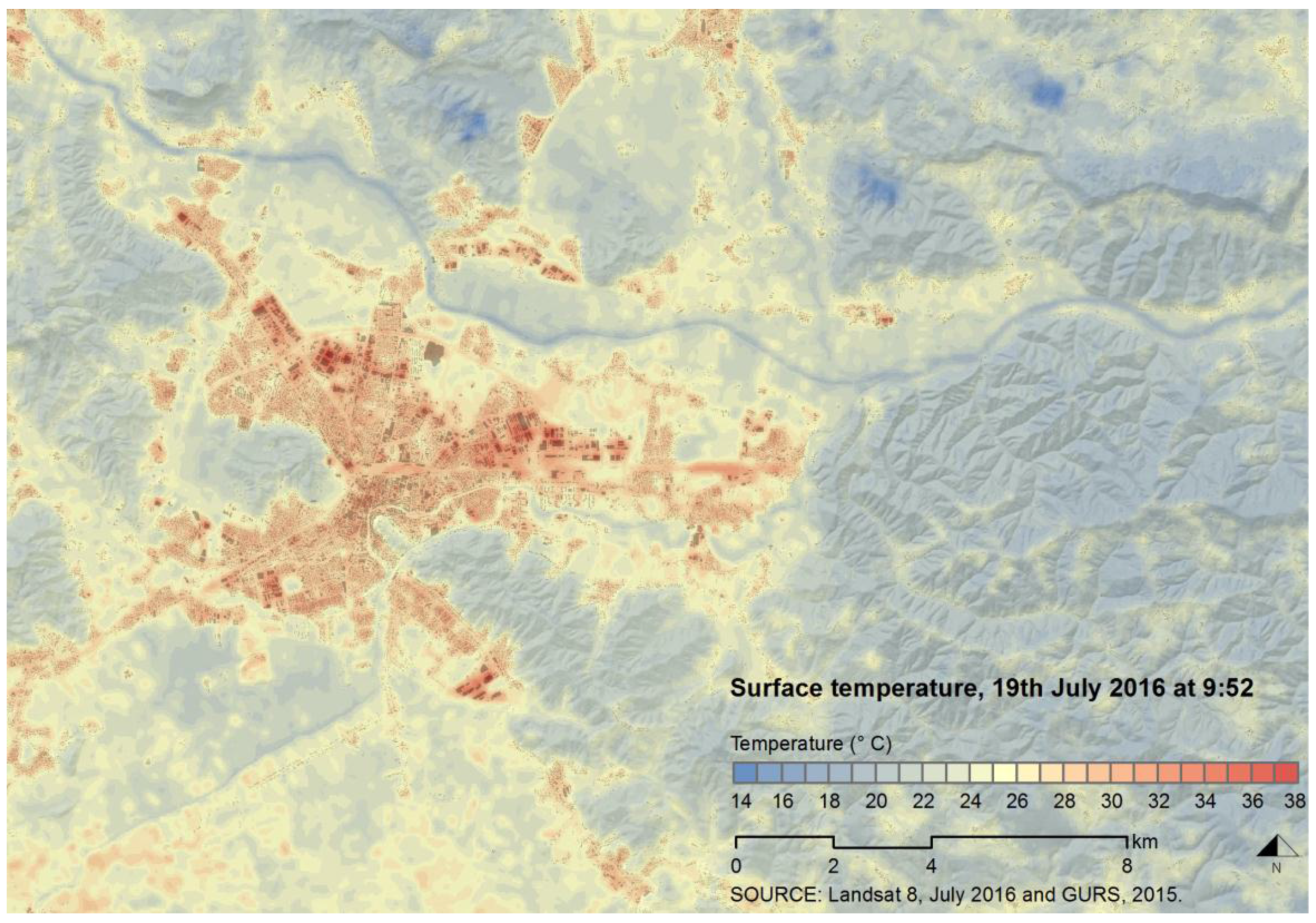

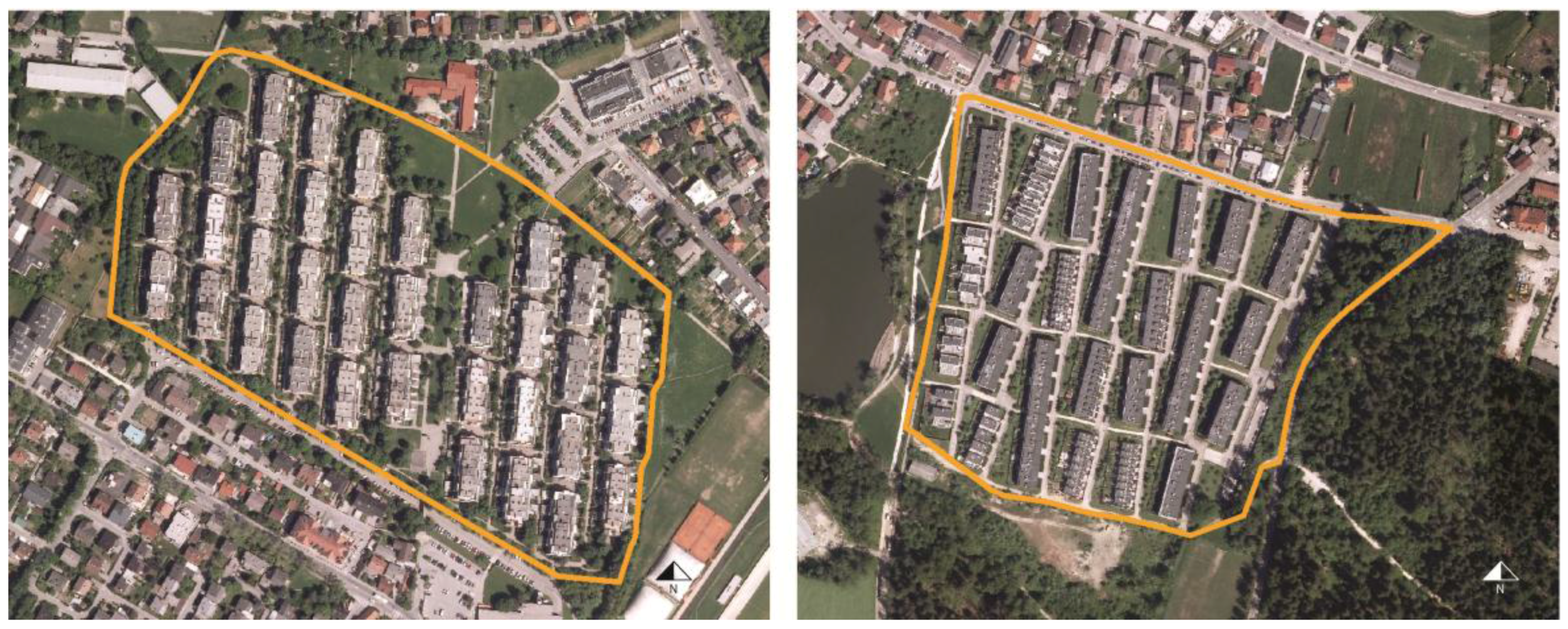
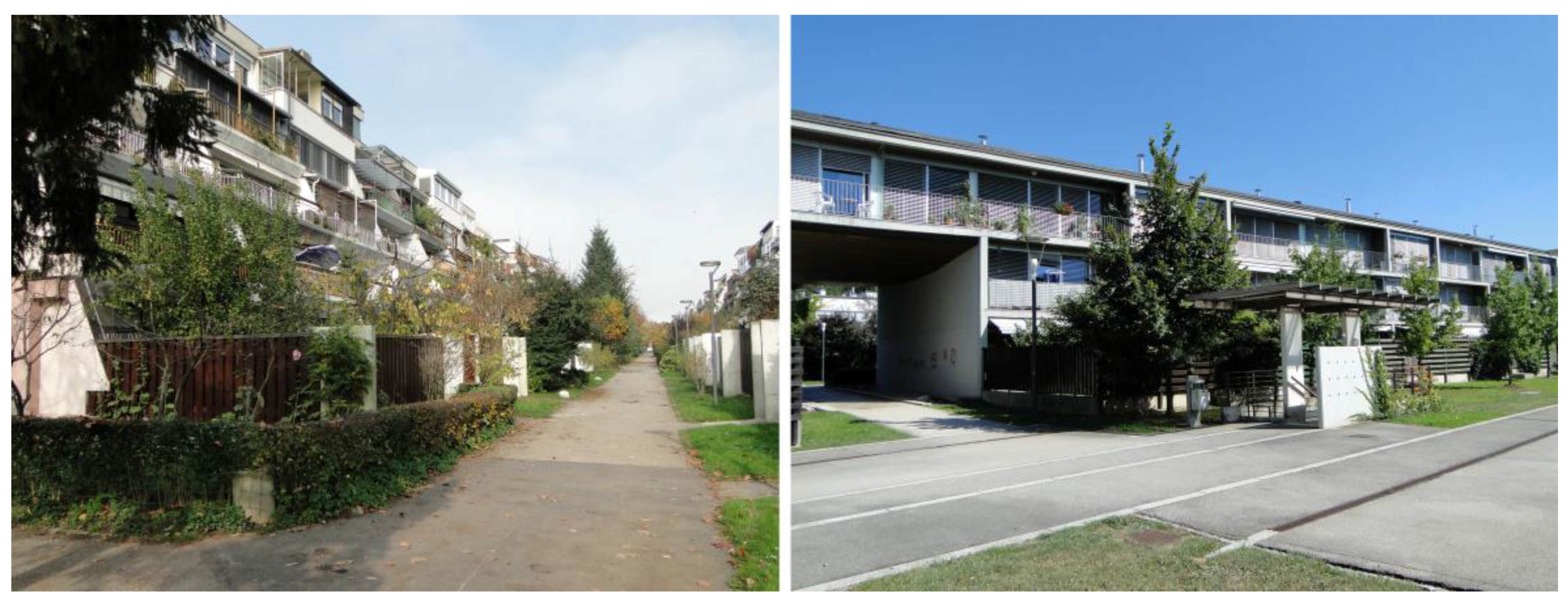
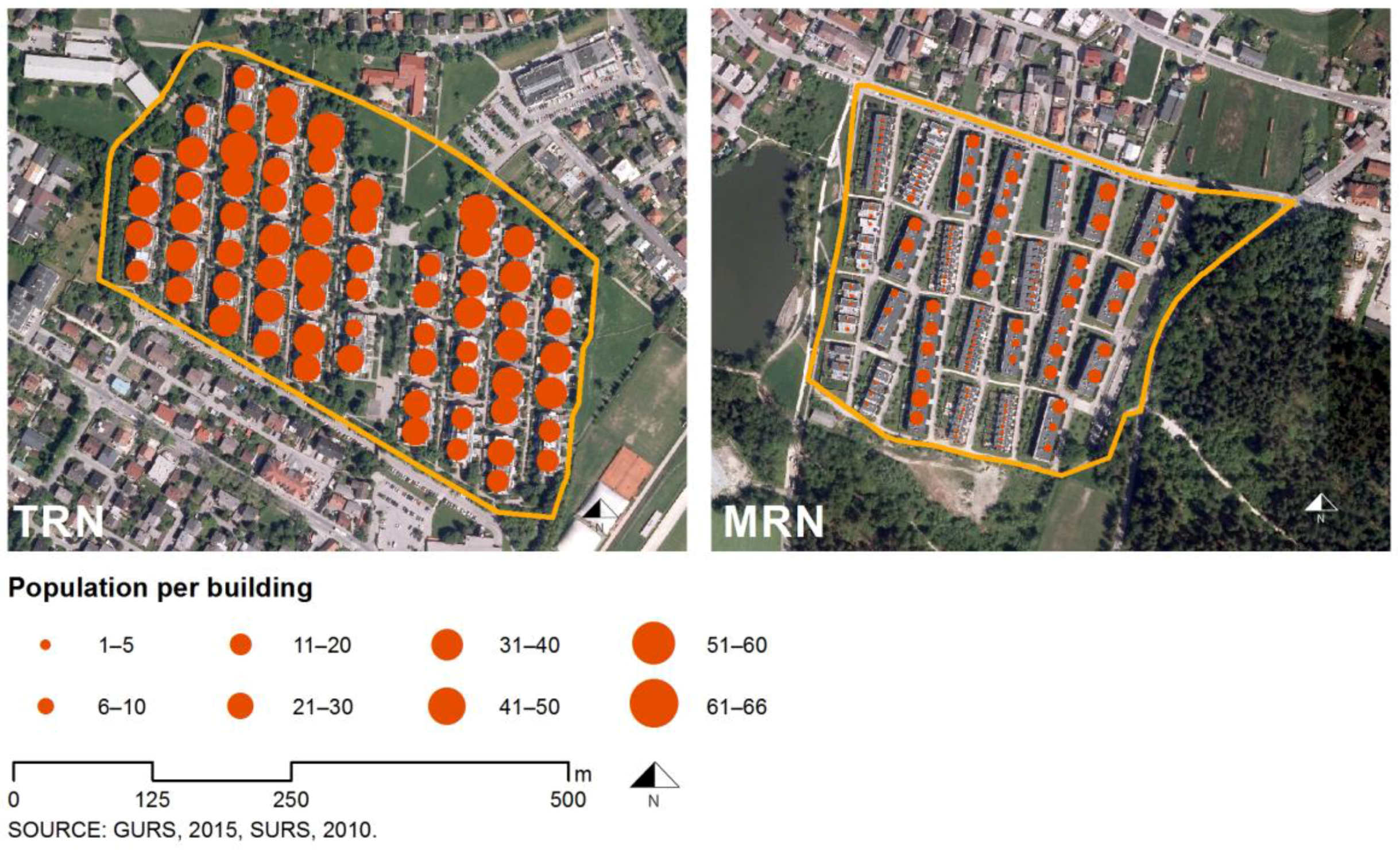
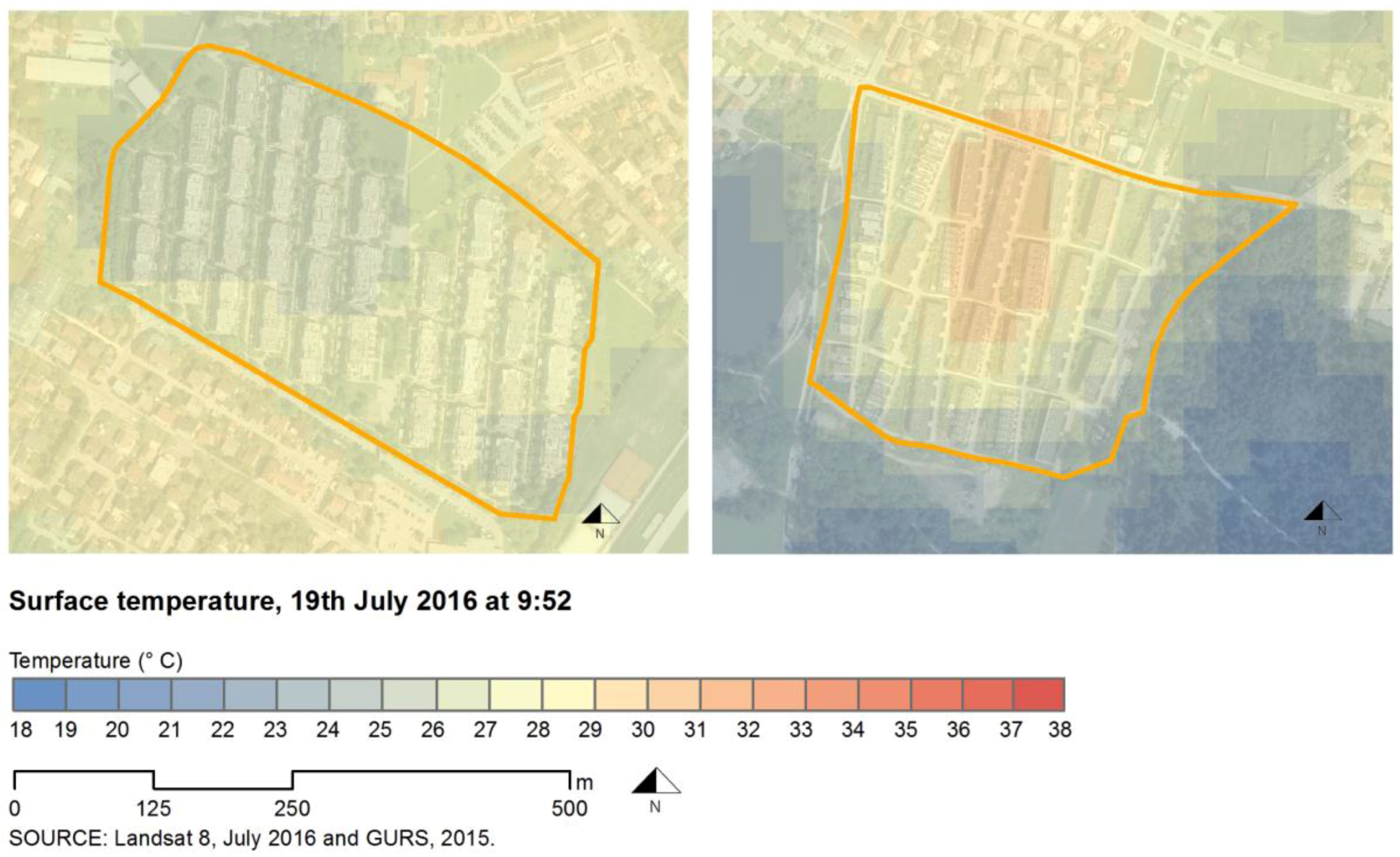
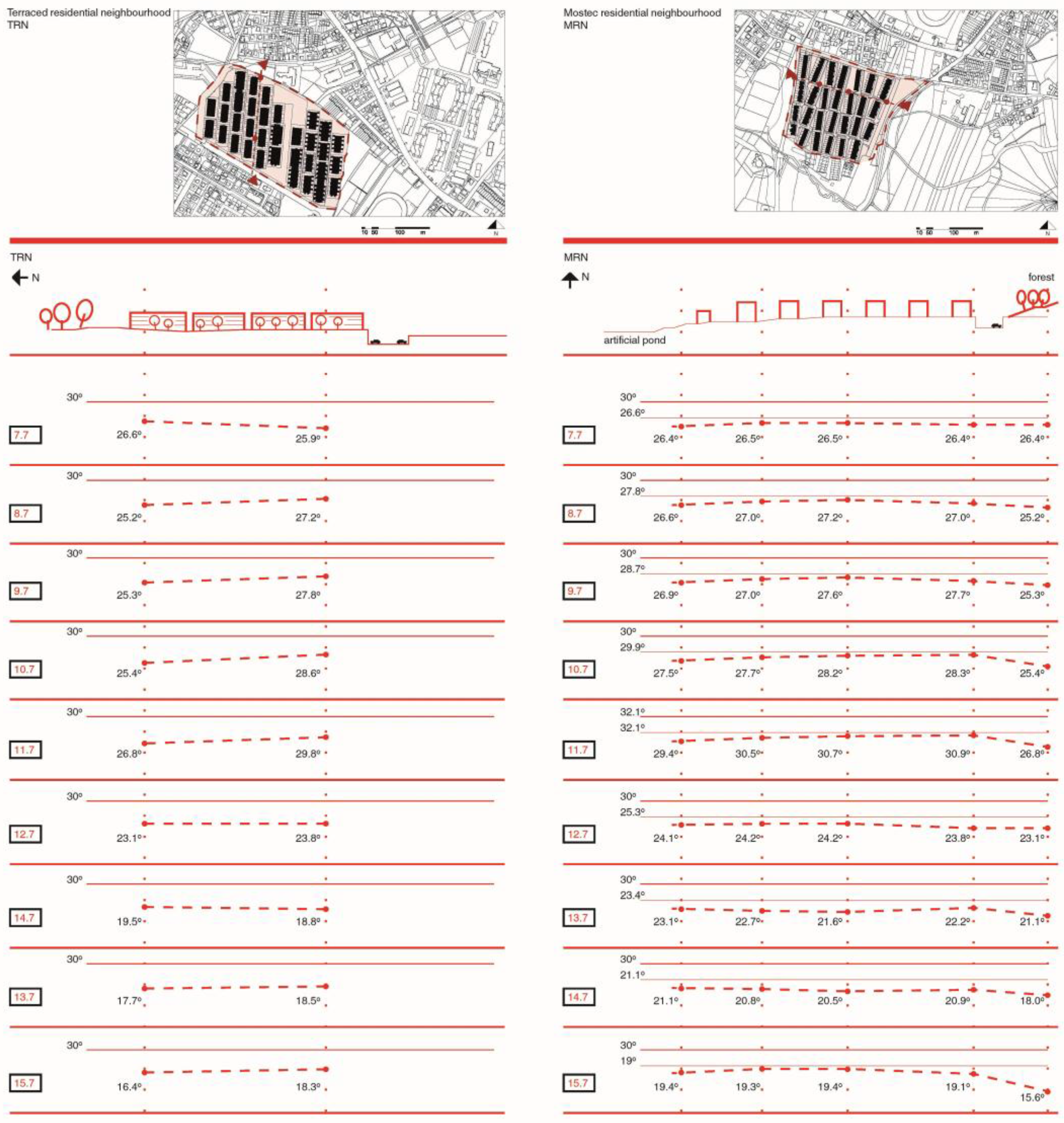
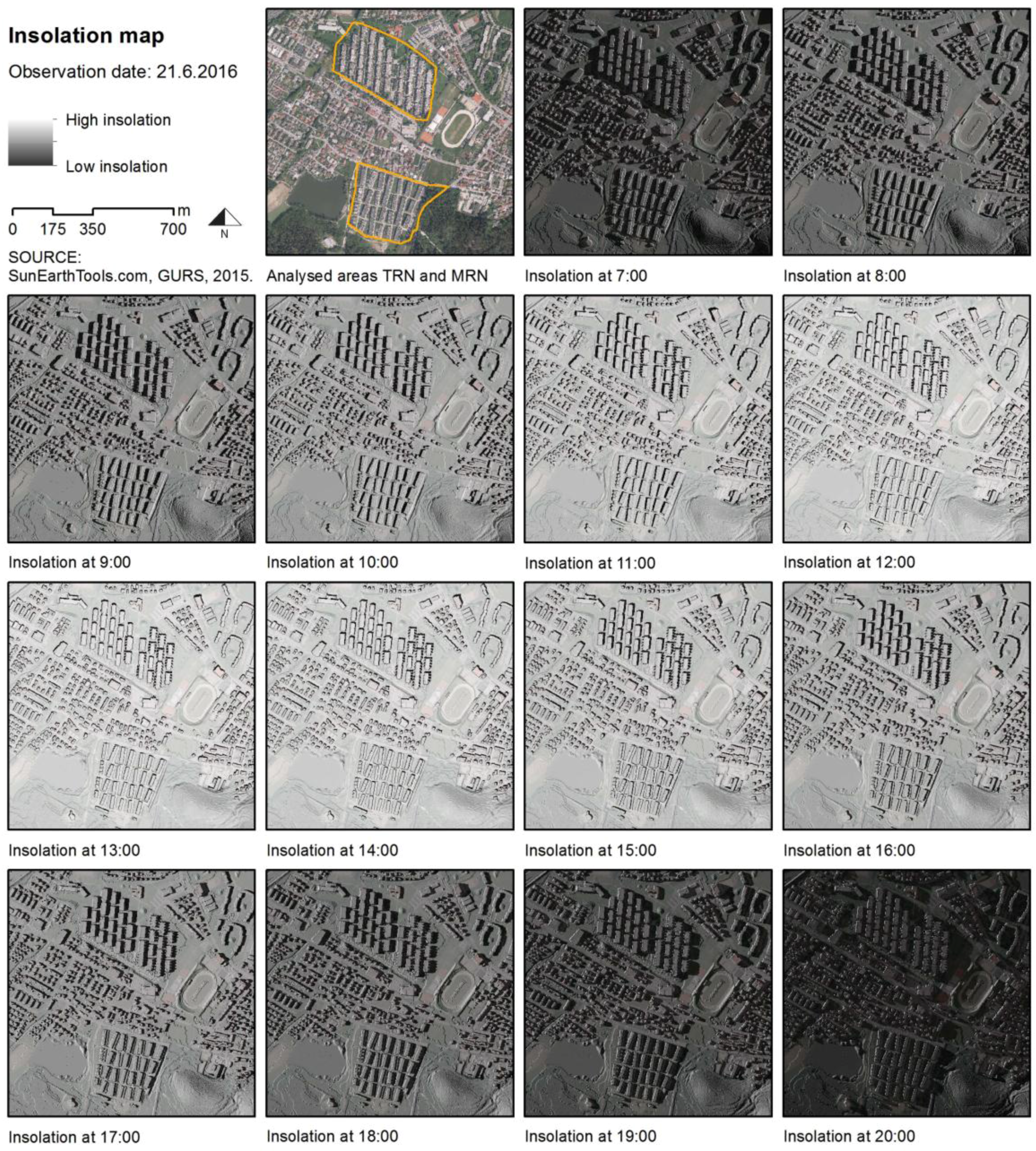
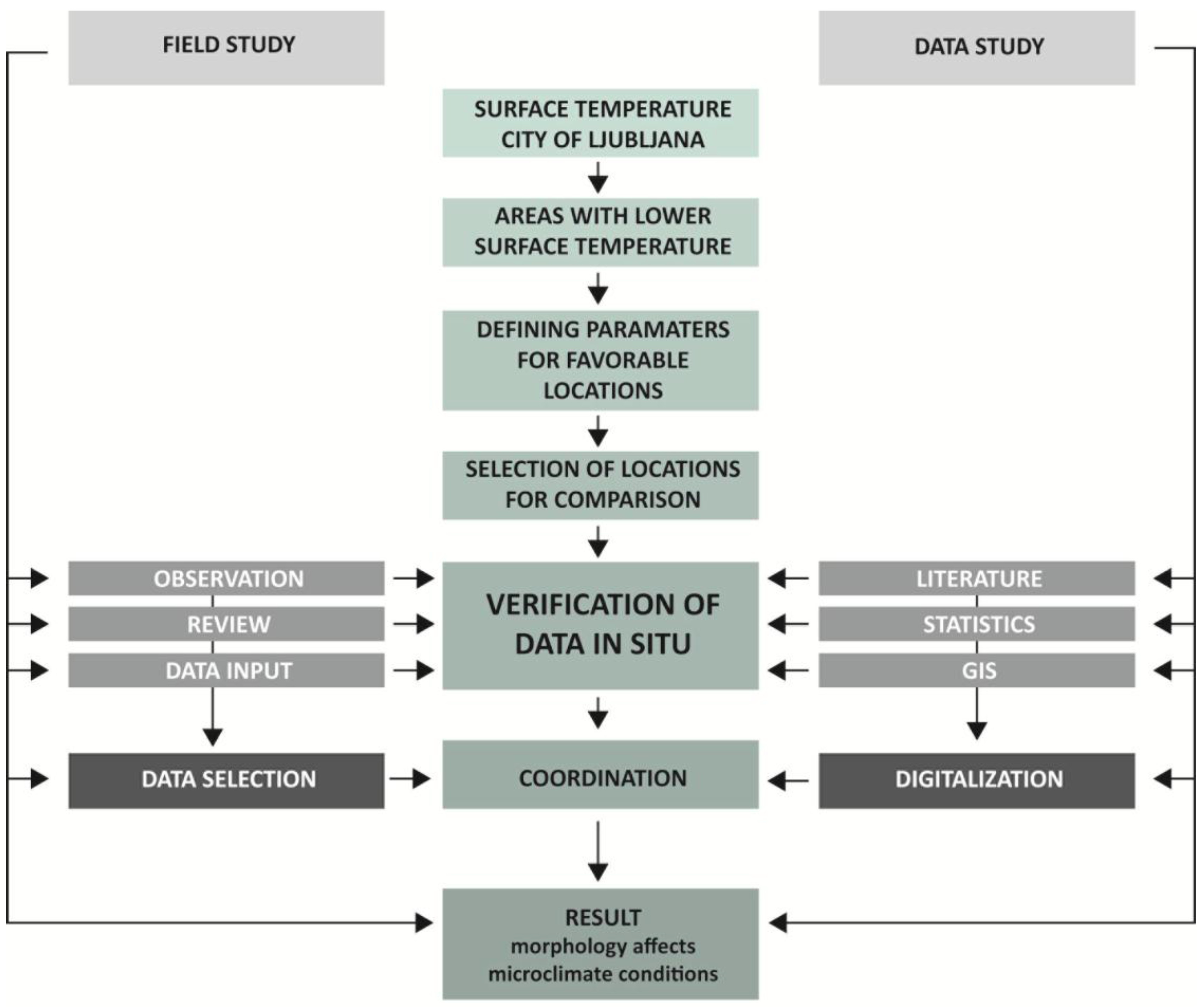
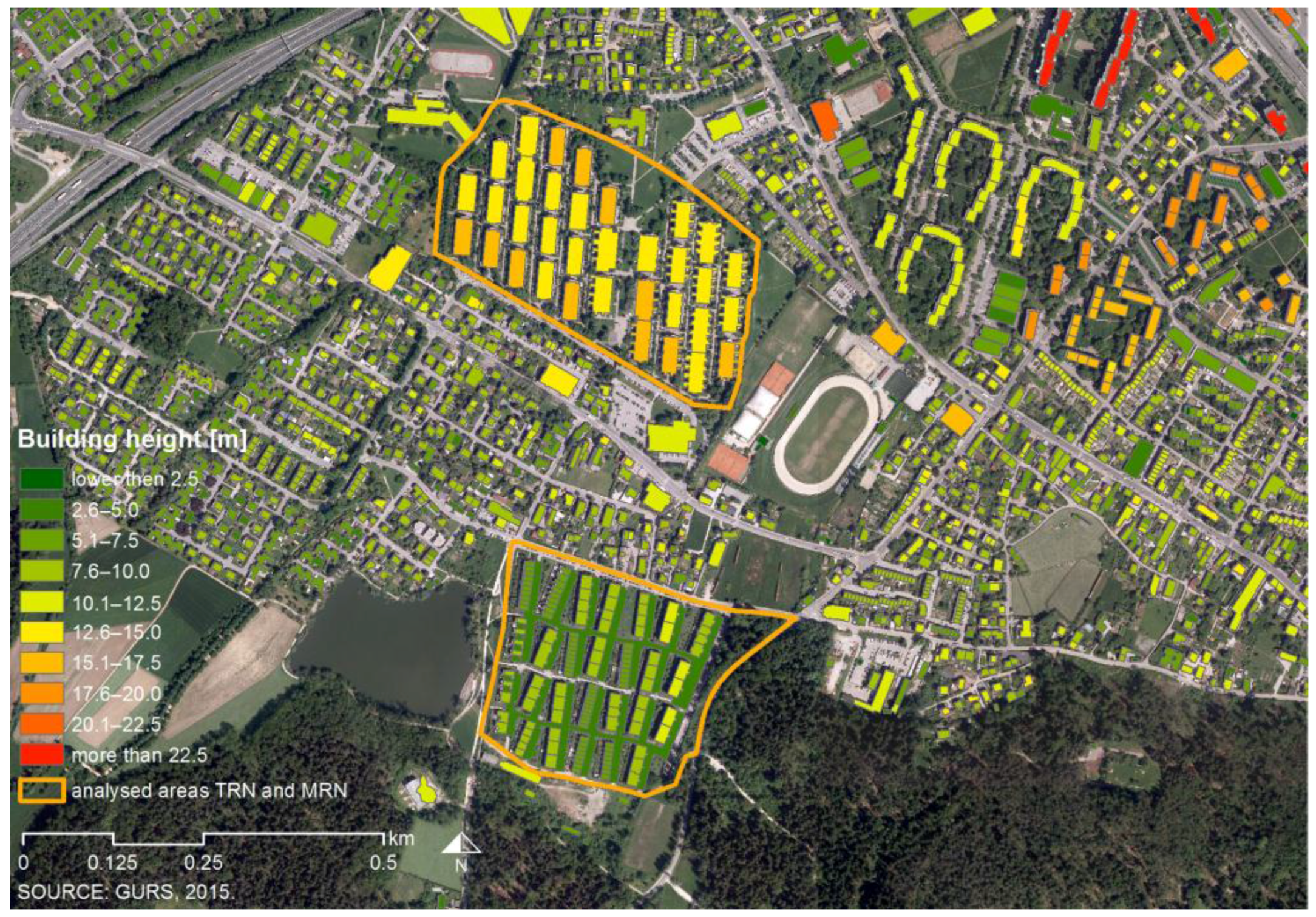

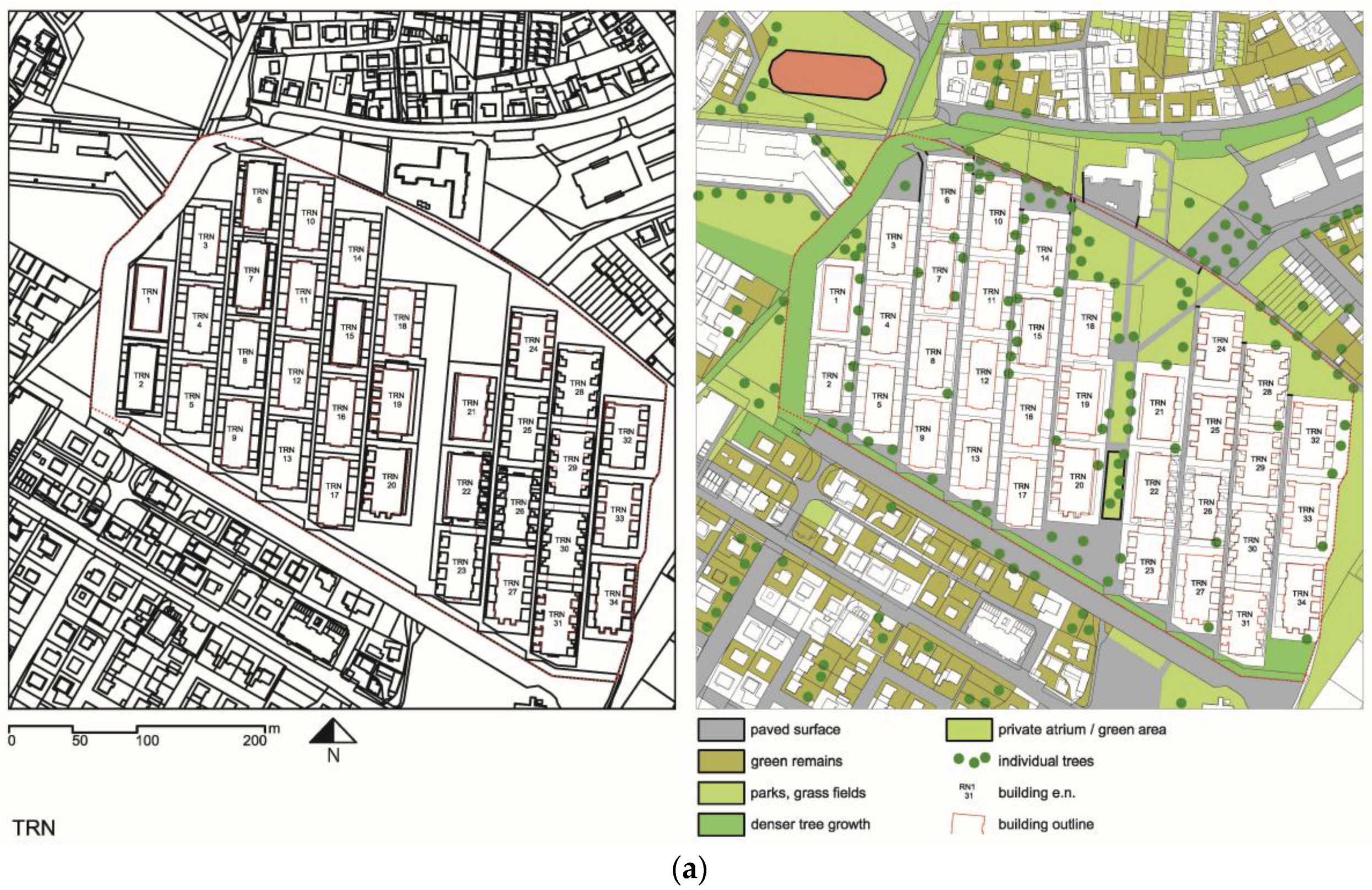
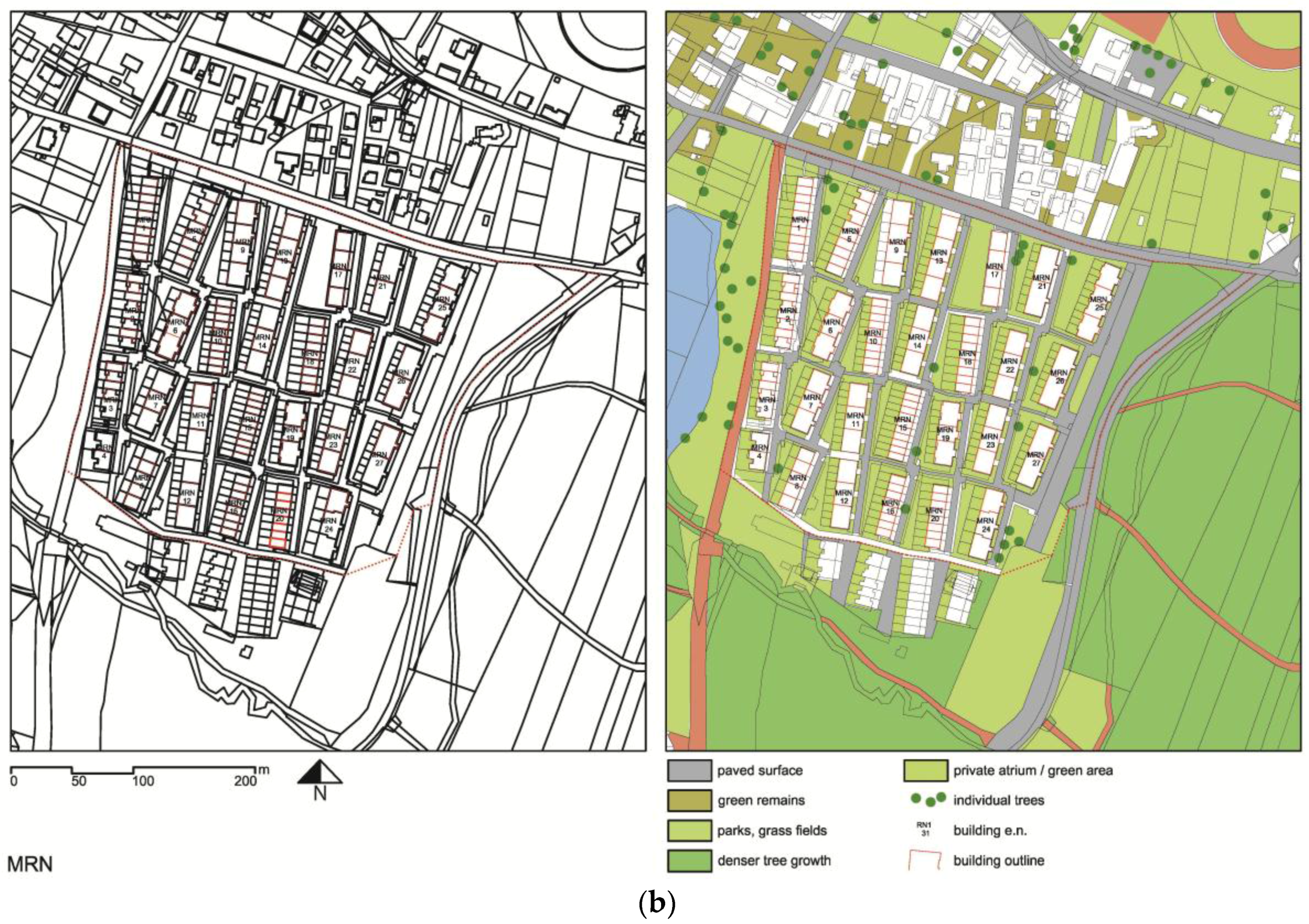
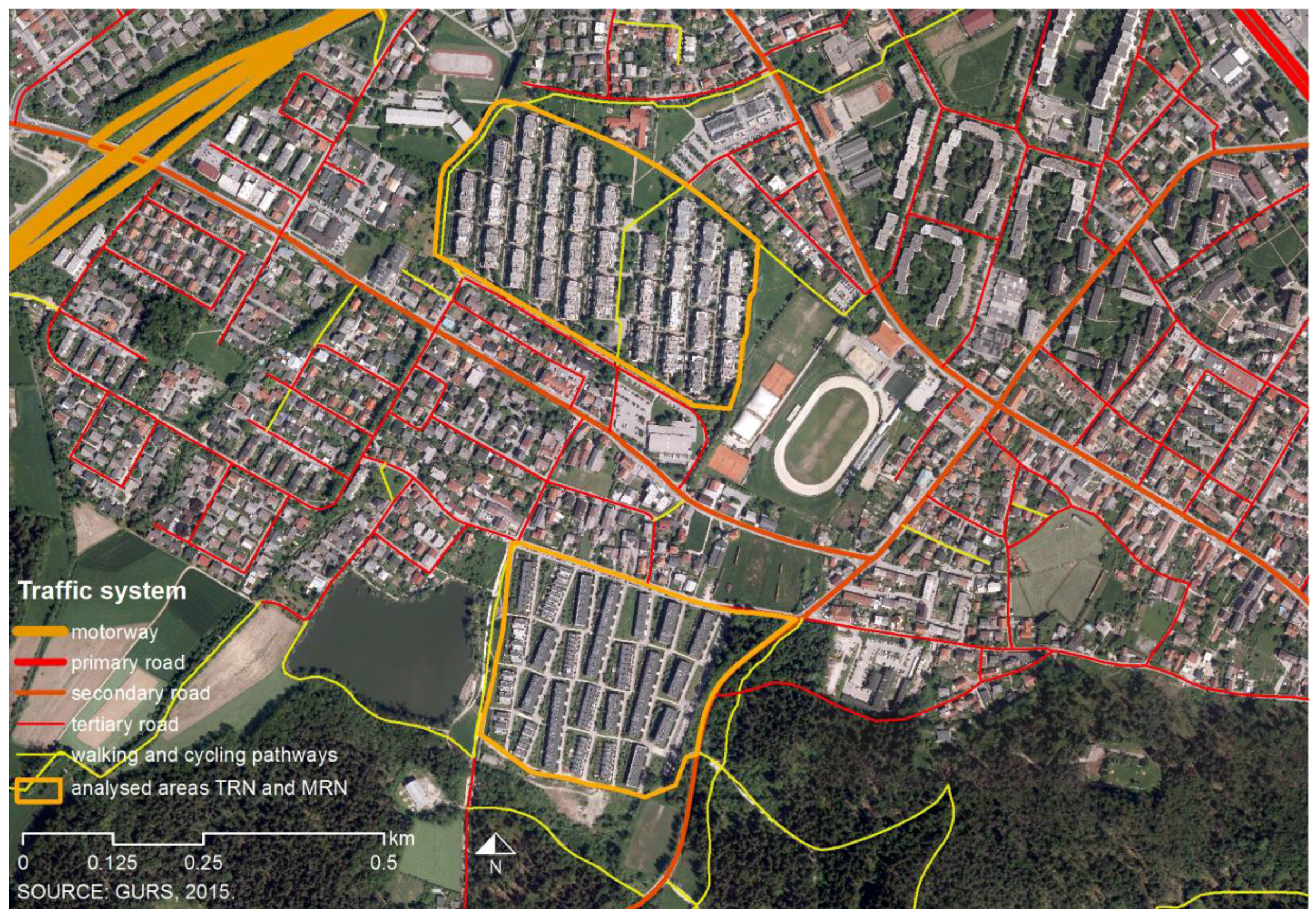
| Neighborhood | Total Neighborhood Area (m2) | House Numbers | Number of Buildings | Average Building High (m) | Surface Covered by Buildings (m2) | Surface Covered by Buildings (%) | Population | Population Density (pop/km2) |
|---|---|---|---|---|---|---|---|---|
| TRN | 114,193.19 | 68 | 35 | 14.63 | 41,829.85 | 36.63 | 3251 | 28,469.29 |
| MRN | 89,712.07 | 136 | 133 | 7.75 | 21,908.22 | 24.40 | 856 | 9541.63 |
| Building ID | Typology | G-Floor Use | Level | Footprint m2 | E-Facade | E-Glazing % (approx.) | W-Facade | W-Glazing % (approx.) |
|---|---|---|---|---|---|---|---|---|
| TRN_1 | R/C | MC | G + 4 | 1050 | PLC | 85% | GF | 85% |
| TRN_2 | R | R | G + 4 | 1100 | PLC | 85% | GF | 85% |
| TRN_3 | R | R | G + 4 | 1100 | PLC | 85% | GF | 85% |
| TRN_4 | R | R | G + 4 | 1100 | PLC | 85% | GF | 85% |
| TRN_5 | R | R | G + 4 | 1100 | PLC | 85% | GF | 85% |
| TRN_6 | R | R | G + 4 | 1100 | PLC | 85% | GF | 85% |
| TRN_7 | R | R | G + 4 | 1100 | PLC | 85% | GF | 85% |
| TRN_8 | R | R | G + 4 | 1100 | PLC | 85% | GF | 85% |
| TRN_9 | R | R | G + 4 | 1100 | PLC | 85% | GF | 85% |
| TRN_10 | R | R | G + 4 | 1100 | PLC | 85% | GF | 85% |
| TRN_11 | R/C | MC | G + 4 | 1100 | PLC | 85% | GF | 85% |
| TRN_12 | R | R | G + 4 | 1100 | PLC | 85% | GF | 85% |
| TRN_13 | R | R | G + 4 | 1100 | PLC | 85% | GF | 85% |
| TRN_14 | R | R | G + 4 | 1100 | PLC | 85% | GF | 85% |
| TRN_15 | R | R | G + 4 | 1100 | PLC | 85% | GF | 85% |
| TRN_16 | R/C | CO | G + 4 | 1100 | PLC | 85% | GF | 85% |
| TRN_17 | R | R | G + 4 | 1100 | PLC | 85% | GF | 85% |
| TRN_18 | R | R | G + 4 | 1100 | PLC | 85% | GF | 85% |
| TRN_19 | R/C | C | G + 4 | 1280 | PLC | 85% | GF | 85% |
| TRN_20 | R/C | C | G + 4 | 1370 | PLC | 85% | GF | 85% |
| TRN_21 | R/C | C | G + 4 | 1200 | PLC | 85% | GF | 85% |
| TRN_22 | R/C | C | G + 4 | 1200 | PLC | 85% | GF | 85% |
| TRN_23 | R/C | C/Cons | G + 4 | 1280 | PLC | 85% | GF | 85% |
| TRN_24 | R | R | G + 4 | 1260 | PLC | 85% | GF | 85% |
| TRN_25 | R | R | G + 4 | 1230 | PLC | 85% | GF | 85% |
| TRN_26 | R | R | G + 4 | 950 | PLC | 85% | GF | 85% |
| TRN_27 | R | R | G + 4 | 1200 | PLC | 85% | GF | 85% |
| TRN_28 | R/C | SC | G + 4 | 1480 | PLC | 85% | GF | 85% |
| TRN_29 | R | R | G + 4 | 1200 | PLC | 85% | GF | 85% |
| TRN_30 | R | R | G + 4 | 1480 | PLC | 85% | GF | 85% |
| TRN_31 | R | R | G + 4 | 1310 | PLC | 85% | GF | 85% |
| TRN_32 | R | R | G + 4 | 1200 | PLC | 85% | GF | 85% |
| TRN_33 | R/C | AC | G + 4 | 1200 | PLC | 85% | GF | 85% |
| TRN_34 | R/C | TO | G + 4 | 1200 | PLC | 85% | GF | 85% |
| TOTAL m2 | 39,790 | |||||||
| AREA m2 | 114,193 | FIS | 0.35 |
| Building ID | Typology | G-Floor Use | Level | Footprint m2 | E-Facade | E-Glazing % (approx.) | W-Facade | W-Glazing % (approx.) |
|---|---|---|---|---|---|---|---|---|
| MRN_1 | RH | R | G + 1 | 900 | W | 50% | GF | 70% |
| MRN_2 | RH | R | G + 1 | 660 | G | 50% | GF | 70% |
| MRN_3 | RH | R | G + 1 | 495 | G | 50% | GF | 70% |
| MRN_4 | RH | R | G + 1 | 380 | G/B | 50% | G/B | 70% |
| MRN_5 | RH | R | G + 1 | 990 | G | 70% | GF | 70% |
| MRN_6 | R | R | G + 2 | 570 | Y | 70% | GF | 70% |
| MRN_7 | R | R | G + 2 | 810 | Y | 70% | GF | 70% |
| MRN_8 | RH | R | G + 1 | 650 | G | 50% | GF | 70% |
| MRN_9 | R | R | G + 2 | 1160 | Y | 40% | Z | 60% |
| MRN_10 | RH | R | G + 1 | 750 | R/G | 50% | GF | 70% |
| MRN_11 | R | R | G + 2 | 850 | G | 90% | Gr | 50% |
| MRN_12 | R | R | G + 2 | 850 | G | 90% | Gr | 50% |
| MRN_13 | R | R | G + 2 | 1150 | LPG | 90% | G | 50% |
| MRN_14 | R | R | G + 2 | 850 | G | 90% | G | 50% |
| MRN_15 | RH | R | G + 1 | 770 | W | 50% | GF | 70% |
| MRN_16 | RH | R | G + 1 | 680 | W | 50% | GF | 70% |
| MRN_17 | R/C | C | G + 1 | 760 | G/B | 60% | G/B | 45% |
| MRN_18 | RH | R | G + 1 | 760 | Y | 50% | GF | 70% |
| MRN_19 | R | R | G + 2 | 780 | Y | 50% | Y | 50% |
| MRN_20 | RH | R | G + 1 | 650 | Y | 50% | GF | 70% |
| MRN_21 | R | R | G + 3 | 880 | B | 50% | B | 70% |
| MRN_22 | R | R | G + 2 | 850 | Gr | 90% | Gr | 50% |
| MRN_23 | R | R | G + 2 | 850 | Gr | 90% | Gr | 50% |
| MRN_24 | R | R | G + 2 | 890 | Y | 50% | Y | 50% |
| MRN_25 | R | R | G + 2 | 970 | G | 50% | G | 50% |
| MRN_26 | R | R | G + 3 | 780 | B | 50% | B | 50% |
| MRN_27 | R | R | G + 3 | 850 | B | 50% | B | 50% |
| TOTAL m2 | 21,535 | |||||||
| AREA m2 | 89,712 | FIS | 0.24 |
© 2017 by the authors; licensee MDPI, Basel, Switzerland. This article is an open access article distributed under the terms and conditions of the Creative Commons Attribution (CC-BY) license (http://creativecommons.org/licenses/by/4.0/).
Share and Cite
Fikfak, A.; Kosanović, S.; Konjar, M.; Grom, J.P.; Zbašnik-Senegačnik, M. The Impact of Morphological Features on Summer Temperature Variations on the Example of Two Residential Neighborhoods in Ljubljana, Slovenia. Sustainability 2017, 9, 122. https://doi.org/10.3390/su9010122
Fikfak A, Kosanović S, Konjar M, Grom JP, Zbašnik-Senegačnik M. The Impact of Morphological Features on Summer Temperature Variations on the Example of Two Residential Neighborhoods in Ljubljana, Slovenia. Sustainability. 2017; 9(1):122. https://doi.org/10.3390/su9010122
Chicago/Turabian StyleFikfak, Alenka, Saja Kosanović, Miha Konjar, Janez P. Grom, and Martina Zbašnik-Senegačnik. 2017. "The Impact of Morphological Features on Summer Temperature Variations on the Example of Two Residential Neighborhoods in Ljubljana, Slovenia" Sustainability 9, no. 1: 122. https://doi.org/10.3390/su9010122
APA StyleFikfak, A., Kosanović, S., Konjar, M., Grom, J. P., & Zbašnik-Senegačnik, M. (2017). The Impact of Morphological Features on Summer Temperature Variations on the Example of Two Residential Neighborhoods in Ljubljana, Slovenia. Sustainability, 9(1), 122. https://doi.org/10.3390/su9010122








